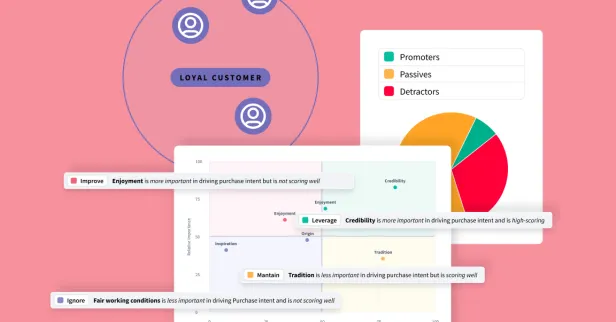Quirks Chicago 2025 was a showcase of cutting-edge trends in consumer insights, with a strong focus on artificial intelligence (AI), agility in product innovation, and the power of consumer co-creation. As the research landscape evolves, brands are increasingly adopting smarter, faster, and more consumer-centric strategies to drive innovation. Here are the key themes that emerged from the event:
1. AI as a Driver of Faster, Smarter Insights
AI’s integration with traditional research methodologies is becoming a game-changer in consumer insights. A Strategy Studio presentation demonstrated how AI can reduce project timelines dramatically, turning months-long processes into days. This enables companies to harness faster, better, and cheaper results without sacrificing quality. Their AI-driven approach has already enabled them to collaborate with over 35 global clients, driving innovation in sectors like healthcare, FMCG, and CPG.
Similarly, Church and Dwight’s partnership with Simporter AI highlighted AI’s ability to uncover market opportunities and trends by analyzing vast data sets. Combining AI with human expertise allows for rapid innovation, providing high-potential concepts ready for market testing. This agility in insights gives brands the flexibility to make strategic decisions quickly, driving faster and more informed actions.
However, one key takeaway from the event was that while AI’s potential is undeniable, it is an enabler, not a replacement for human insights. Kikke Riedel, VP of Strategy at MilkPEP, emphasized that AI has accelerated the research process, reducing costs and lowering risks. But when it comes to understanding deep emotional insights, AI still falls short. True innovation, according to experts like Valerie Sokolova of Kraft Heinz, comes from the deep, qualitative understanding of consumer behavior—the kind that AI cannot replicate.
2. The Power of Co-Creation in Product Innovation
Co-creation emerged as a powerful theme throughout the event, emphasizing the benefits of collaborating with consumers early in the product development process. Sargento and Curion showcased how integrating consumer insights into each development stage—from concept to final product—leads to more relevant, successful innovations. This agile innovation approach not only reduces time to market but also ensures a stronger product-market fit by constantly iterating based on real-time feedback.
Cheez-It further embraced co-creation through an AI-powered mobile chat platform, engaging consumers to test new flavors. This approach allowed the brand to gather deeper insights into consumer preferences and refine R&D briefs, resulting in the successful launch of their new Smoked flavors.
3. Consumer Emotions and Nostalgia in Brand Development
Consumer emotions, particularly nostalgia, were central to brand development discussions. J&J Snacks’ work with iconic brands like Dippin' Dots and ICEE revealed how leveraging nostalgic connections can drive brand loyalty and growth. Using AI-driven platforms like Quantum, J&J Snacks gathered insights into consumer perceptions and brand associations, ensuring that new product innovations maintained the brands’ nostalgic appeal while staying relevant to modern consumers.
This blend of qualitative and quantitative research methods allowed J&J Snacks to refine their brand strategies and ensure emotional resonance with their audience. The result was an innovative yet familiar approach that connected deeply with consumers on a personal level.
4. Unlocking the Power of Human Connection in Qualitative Research
While AI continues to drive efficiencies in insights gathering, human connections in qualitative research remain invaluable. A panel discussion highlighted the importance of real-time, human-driven interactions in understanding the nuances of consumer behavior. Experts from Major League Baseball, PepsiCo, and Kraft Heinz shared how qualitative research led to richer, more authentic insights, such as in Gatorade’s creative review, where respondents shared personal sports stories. This provided a deeper level of feedback that ultimately improved the final ad.
The panel also emphasized the role of qualitative insights in driving market innovations, like Daisy Squeeze sour cream, which was born from observing consumer frustrations with traditional packaging. Qualitative research led to the development of the squeezable product, which has since outperformed its competitors. These examples reinforced the need for deep, human connections in research, underscoring that AI alone cannot capture the emotional depth and subtle insights that come from direct consumer interactions.
5. Agility and Flexibility in Innovation Testing
Agility was a recurring theme throughout the event, particularly in the context of product testing. The ability to test quickly and iterate based on real-time consumer feedback is crucial in today’s fast-paced market. Cheez-It’s use of AI-powered mobile platforms for instant feedback allowed them to streamline the testing process and make decisions faster. Bayer and Coca-Cola’s collaboration on prebiotic sodas also demonstrated the importance of flexibility in exploring new product categories. Their ability to rapidly refine their approach based on consumer responses helped make their health-focused beverage, Simply Pop, a success.
6. Reimagining Knowledge Management in the Age of AI
AI-driven platforms are transforming knowledge management, making it easier for teams to access, analyze, and synthesize consumer insights across various geographies and brands. Market Logic Software’s platform exemplified this by providing teams with a one-stop solution to curate and understand marketing and consumer insights. By integrating various content types—including reports, visual data, and structured databases—the platform allows for real-time answers to business questions, ensuring that teams can leverage past research effectively.
For companies like Mars, this AI-driven approach has led to significant cost savings and improved decision-making. With features like personalized feeds and knowledge zones, the platform allows users to search, organize, and access content relevant to their roles, improving efficiency and collaboration across teams.
7. Leveraging AI for Smarter Strategy Across Categories
AI’s ability to uncover market opportunities and identify white spaces was another key theme. The partnership between Simporter AI and Church and Dwight showcased how AI can be used to explore niche markets and emerging trends. By analyzing large data sets, brands can stay ahead of the competition and develop solutions that resonate with consumers. This ability to spot unmet needs in mature markets enables brands to adapt and innovate quickly, ensuring that they remain relevant in a fast-evolving landscape.
8. AI's Role in Consumer Insights: Revolutionary, But Not a Replacement
As Quirks Chicago 2025 made clear, while AI is revolutionizing the consumer insights landscape, it does not replace the need for human understanding. AI excels at generating quick, actionable insights, but true innovation and consumer connection still require a deep dive into emotional insights. According to Hally Jhass from Keurig Dr Pepper, AI-backed insights help bridge the gap between consumer needs and business decisions, but qualitative research remains essential for digging into the "why" behind consumer behavior.
Tim Lawton of SightX and his colleagues highlighted that embracing AI in consumer insights requires a cultural shift. It’s not just about having the right technology—it’s about transforming how organizations think, act, and integrate insights into decision-making. Platforms like SightX, which offer end-to-end, automated quantitative research, help teams move faster without sacrificing quality—empowering insights professionals to focus more on strategy and storytelling. For a deeper dive into this topic, check out this blog post featuring insights and takeaways from their session - or check out a visual recap of the SightX session to see the team in action.
Conclusion: A Future-Ready Landscape for Consumer Insights
Quirks Chicago 2025 highlighted the increasingly vital role of AI in reshaping the consumer insights and product development landscape. From AI-driven research platforms to co-creation and agility in testing, the event showcased how brands are adopting more efficient, consumer-centric approaches to innovation. As AI continues to evolve, its role in enhancing productivity, enabling smarter strategies, and driving deeper consumer connections will only grow, positioning it as an essential tool for the future of consumer insights.
In this new landscape, combining AI with human expertise, understanding consumer emotions, and fostering collaboration through co-creation will be key to developing products and strategies that truly resonate with today’s consumers.

